
- Home
- Memories
- Scrapbook ▽
- Topics ▽
- People ▽
- Events
- Photos
- Site Map
- Timeline
Also see list of Bishops of Exeter
The site of Exeter Cathedral and the area around about has been the heart of Exeter since Roman times - indeed the first Roman stone structure in their garrison was a bath house, in Cathedral Close. Cleanliness was next to godliness, even for the Romans. The Romans probably had a temple somewhere around the city and the odd shrine or two. They had a burial site outside the city walls at the junction of Magdalen Street, Holloway Road and South Street. Figurines and other objects that would have had religious significance have been found alongside the cremated remains of soldiers.
However, the Cathedral area was not a centre of worship until Saxon times. There is evidence of Saxon Christian burials in Cathedral Yard on the grassy area close to the Devon War Memorial, and the foundations of a minster or monastery which was established in the late 7th century has been found in the same area. The Crediton born St Boniface, the patron saint of Germany, was educated at the minster in AD 680. Apart from the minster, Exeter was more or less abandoned and the town did not start to regenerate until the time of King Alfred the Great AD 871-899, when he wasn't burning his cakes! After a few problems with the Vikings in 1003 when they burnt down the minster, things started to improve.
By about 1000 AD, Exeter was the sixth most prosperous city in Britain. It continued to grow and by the 11th century, tin was the basis of the city's wealth. Growth was such that the city had as many as 30 churches and Preston Street, or street of priests, was a whole street of priests!
In 1050, Leofric, Bishop of Crediton gained permission to move the Bishop's 'stool' from Crediton to Exeter, partly because he felt the walls of Exeter would provide better protection from lawlessness than the more open Crediton. Leofric then converted the existing minster into his cathedral. Crediton still has its own bishop who resides at 10 The Close.
After the Norman invasion and the subsequent taking of Exeter, a program of church building was embarked upon in England. William gave the monks of Battle Abbey, St Olaves and they established St Nicholas' Priory. In 1114, Bishop Warelwast, nephew of the Conqueror, started building a new, vast Cathedral church in the popular Romanesque style. The quire was consecrated in 1133, allowing the clergy to worship in the new building for the first time. In 1136 a major fire caused damage to the nave, during the siege of Exeter by King Stephen, against Baldwin de Redvers. Stephen built the siege castle at Danes Castle to help in the action, which lasted three months, before a food shortage brought it to an end. Anyway, all this warfare delayed the completion of the nave until the end of the 12th century. The two massive towers are the main surviving structures from this period of building, having been completed by about 1200. Take a closer look at the towers and you will notice the round arched windows, whereas the later parts of the Cathedral have pointed arches.
Bishop Branscombe started expanding the Cathedral with the construction of the Lady Chapel in 1270 and the remodelling of the quire. The whole of Cathedral Close became a huge building site, attracting commerce and the resulting revelry and bad behaviour of the labourers, artisans and traders. In 1283, John Pycot, a local was elected Dean of Exeter in doubtful circumstances. Bishop Peter Quinel cried 'foul' and attempted to have Pycot removed from office. This caused dissent in the chapter and controversy throughout the city, leading to the murder of one of the Bishop's hardmen, Walter Lechlade. He was hunted down by Pycot's men and stabbed to death, when walking from matins at 1 or 2 am on 5th November 1283, across Cathedral Close. Lechlade's family were obviously a little upset by the turn of events and they brought proceedings against Pycot, the city Mayor Alured de Porta, and nineteen other plotters.
Just as today, the case dragged on and on and it was some two years later that Bishop Quinel requested that King Edward I intercede and judge the case against the plotters. The King arrived with Queen Eleanor and three of his daughters on 22nd December, 1285. He then listened to the case on 24th December, had Christmas day off to attend services and eat a slap up turkey dinner (oops, sorry - turkeys hadn't quite been discovered yet! in fact it was oxen and pigs - and quite a lot of them!) and sentenced five plotters and the Mayor to hang on 26th December, with Pycot being banished to a monastery where he eventually died. Alured de Porta has the distinction of being Mayor when he was hung on St Stephen's Day (26th December) as a common felon. Exeter was without a Mayor until the beginning of Lent when a tailor, named David Cissor was chosen for the office. Not a very happy Christmas for some.... it also demonstrates that it pays to be in the clergy when it comes to capital punishment.
On 30th December, Edward gave permission for Bishop Quinel to enclose the Cathedral Yard with a 12 ft high wall and build seven gates that would be closed from dusk to dawn. And therefore, the Cathedral gained a wall within the great city wall. The friction between the Cathedral and the secular city was not totally solved, but it was reduced.
Thus, how events shape a space, and a space shape a people. The sites of Broadgate, Palace Gate, Bear Gate, Little Stile, St Martin's Gate, St Catherines Gate and St Petroc's Church can all be traced. Over the intervening years, cottages and shops have been built against the wall, lining the close and making it the beautiful area that we see today. The gates were torn down over the years as access needed to be improved into the Close. Posts replace the gates at Broadgate, Martins Lane, and Palace Gate. When Prince Charles visited in 1979, a ribbon was tied between the Broadgate posts to symbolically represent a chain, which were once used to close Cathedral Close off after the gates were removed.
A little after the above rude interruption, work restarted to build the present quire followed by the nave in 1310. The high altar was dedicated in 1328. Bishop John Grandisson added the West Front by 1342, a beautiful facade which at the time was painted in bright colours. Just imagine all those saints, kings and biblical figures painted in a rich rainbow of colour - it would have been stunning! The major construction was now complete, which was just as well because Bishop Grandissons band of talented artisans and craftsman were decimated by the black death which hit Exeter in 1348. A building swan song occurred when the twelve apostles and Christ were added in 1460 to 1480 to the front.
Exeter Cathedral has the longest unbroken stretch of Gothic stone vaulting in the world. Other features of particular interest include the Bishop's Throne, one of the finest pieces of woodwork of the late 14th century and there is original glass in the East Window. The clock in the North Transept dates from 1484 and is thought to be one of only four of its type, in England. In the centre the moon rotates around the earth. It was not until 1760 that the minutes were shown. It was probably made by the monk, Peter Lightfoot.
Anyway, to bring the story up to date - and I have to apologise to any Germans reading this as you seem to get a mention in many stories about Exeter - the poor old Cathedral suffered a direct hit on 4/5th May 1942, blowing out the windows, destroying St James Chapel and much around. After many years, repairs and restoration have been made. The present job of maintaining the Cathedral requires the full time employment of many craftsmen, including carpenters and stone masons. Stonework is being replaced where erosion and pollution have done much damage. Anyone who visits Exeter should visit the Cathedral - such beautiful buildings chart the long and turbulent history of the English people and Exeter Cathedral is no exception.
All the photos and text in Exeter Memories are © 2016 David Cornforth and should not be used without permission.
 A short
film of Exeter Cathedral - from 1950 of the Cathedral masons at
work which is presented through the BBC Creative Archive scheme.
A short
film of Exeter Cathedral - from 1950 of the Cathedral masons at
work which is presented through the BBC Creative Archive scheme.
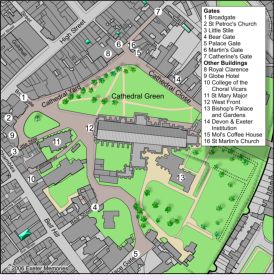 Map of Cathedral Yard
Map of Cathedral Yard
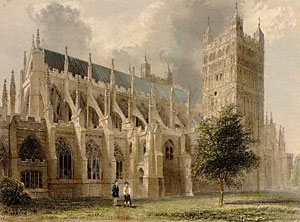 A steel engraving of the Cathedral
from 1837. Courtesy Devon Library and Information Services
A steel engraving of the Cathedral
from 1837. Courtesy Devon Library and Information Services
 The
West Front was added in 1342 - this was richly coloured when completed. Photo David Cornforth
The
West Front was added in 1342 - this was richly coloured when completed. Photo David Cornforth
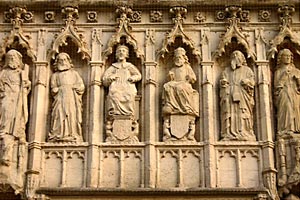 Detail of figures on the West Front. Photo
David Cornforth
Detail of figures on the West Front. Photo
David Cornforth
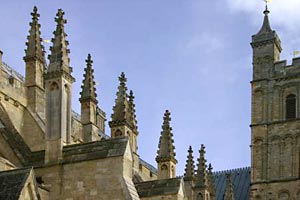 A view of the roof and the
pointed adornment over the flying buttresses. Photo David
Cornforth
A view of the roof and the
pointed adornment over the flying buttresses. Photo David
Cornforth
 Carved angels on
the West Front - the left one is a recent replacement Photo
David Cornforth
Carved angels on
the West Front - the left one is a recent replacement Photo
David Cornforth
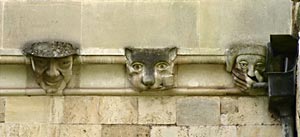 Three grotesques which replaced some
badly worn medieval grotesques in the 1980's. See the story of the smoking dog.
Three grotesques which replaced some
badly worn medieval grotesques in the 1980's. See the story of the smoking dog.
│ Top of Page │